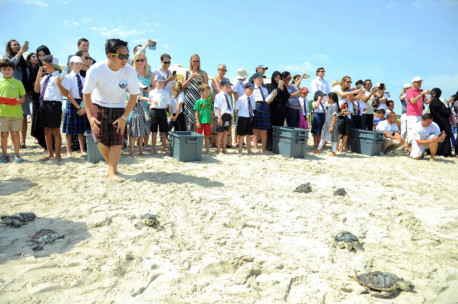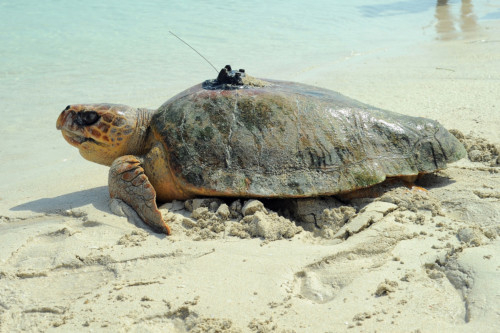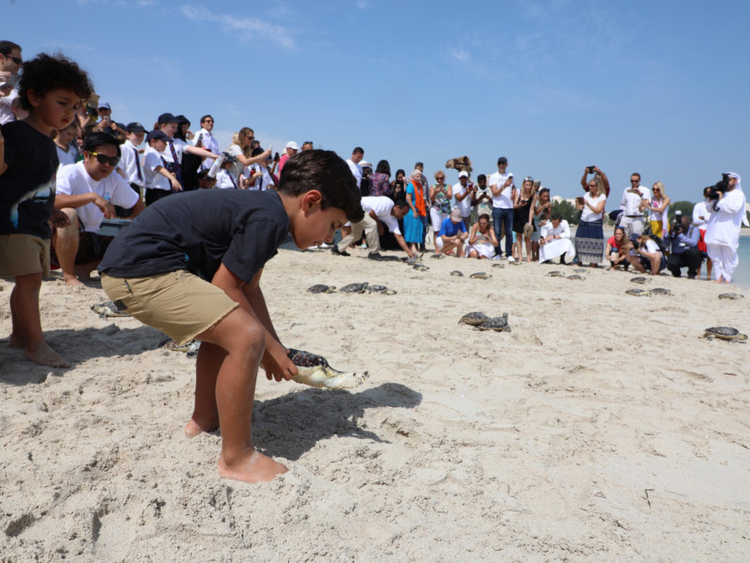
Abu Dhabi: A group of 50 sea turtles that have successfully been rehabilitated were released into the waters of the capital on Thursday.
The turtles were found sick or injured last year on beaches across the emirate of Abu Dhabi, and were rescued by concerned residents, fishermen and rangers with the emirate’s environment sector regulator, the Environment Agency Abu Dhabi (EAD). They were rehabilitated by the Dubai Turtle Rehabilitation Project, a non-profit organisation under the Jumeirah Hotels and Resorts, and were released on the beach of Emirates Palace in Abu Dhabi.
Among the released marine turtles were 49 Hawksbill turtles, which are listed as a Critically Endangered Species facing very high risk of extinction in the wild by the International Union for the Conservation of Nature (IUCN). There was also a Loggerhead turtle, a species that is vulnerable and faces endangerment in the wild.
The release of the turtles was arranged ahead of the worldwide celebration of Endangered Species Day on May 19.
“We are committed towards conserving endangered species, and towards and involving the community and younger generation in these efforts. [Youth who witness these efforts] can connect to the natural heritage and become valuable players in the conservation arena,” said Dr Shaikha Al Daheri, executive director of terrestrial and marine biodiversity at the EAD.
“We also want residents to understand the importance of handing over any endangered wild animals that they find to the authorities for expert care,” she added.
There are three species of marine turtles that live in Abu Dhabi waters — the Hawksbill turtles, the Loggerhead turtles and Green turtles. All are endangered to some extent, Maitha Al Hameli, marines threatened species and habitats specialist, told Gulf News.
Often weighed down by barnacles, the young turtles are sensitive to rough sea and cold conditions and get washed ashore. While some turtles suffer from infections, other threats such as boat collisions and gill net injuries can also be fatal to these animals.
“People find more turtles during the winter months, when the turtles are hibernating and therefore more stationary. Some people have personally called us to find out how they can hand over an injured turtle, and in other cases, we have heard of them through social media posts and retrieved them,” she said.
During the rehabilitation process, the turtles are nursed back to health, and even receive stitches, to repair tears sustained from propeller blades, or undergo surgeries to mend a broken carapace (turtle shell).
Officials of the EAD urged residents to contact the authorities on 800555 whenever they notice any stranded turtles or marine animals.
BOX
Marine turtles in Abu Dhabi
Three species of marine turtles are found in the waters of Abu Dhabi: the Hawksbill (Eretmochelys imbricata), Green turtle (Chelonia mydas) and Loggerhead turtle (Caretta caretta)
These species use UAE waters extensively for foraging and the Hawksbill nests on sandy beaches on several offshore islands.
The Environment Agency Abu Dhabi’s field and survey findings indicated that about 5,750 sea turtles inhabit Abu Dhabi waters during winter, and there are about 6,900 during the summer.
Hawksbill turtles: The Hawksbill turtle is listed as Critically Endangered by the International Union for the Conservation of Nature. They are usually brown with splashes of orange, yellow or reddish-brown, and have elongated or oval shells. Juvenile Hawskbills are black or dark brown, with light brown or yellow on the edge of their shell and limbs. These turtles have small heads with hawk-like beaks, and two claws. They feed on sponges, jellyfish, squid, shrimps and other invertebrates found in coral reefs. In the UAE, Hawksbills have been found to be smaller in size than Hawksbills in other parts of the world, presumably due to the harsh environmental conditions and the availability/quality of food resources. They also have fewer eggs per nest here than in other waters around the world.
Loggerhead turtles: The Loggerhead turtles are listed as Vulnerable by the International Union for the Conservation of Nature. They are usually reddish-brown in adults and sub-adults, with a generally pale yellowish bottom shell. The shell is heart-shaped, and they have large heads with powerful jaws. Loggerheads feed on shells and mollusks and are highly migratory.
If you find a stranded or injured turtle, call the Environment Agency Abu Dhabi on 800 555.















